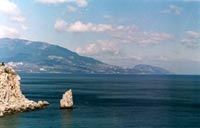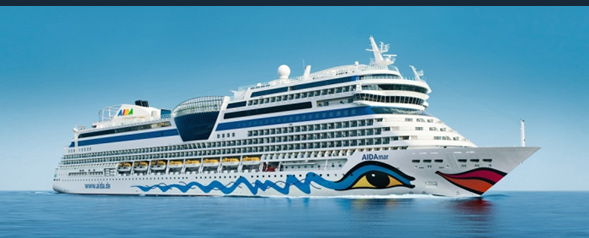The land on which Yalta situated was inhabited by the man long ago. Today's Yalta developed on the place of the Tauri settlement, which was near the former village of Chehovo in I century A.D. Not far from the town archaeologists found things referring to the Stone and Bronze Ages. In the old part of Yalta, on the slope of Polikurovsky Hill and in suburbs of the town there were found the "stone boxes" - burial grounds of the Tauri, ancient inhabitants of the southern coast. The Tauri lived in the Crimea within the period from the X-IX centuries B.C. to the III century A.D. In the scripts of the Greek authors this tribe has bad reputation of cruel pirates, who not only rob travelers, but sacrifice them for their goddess Virgo. But it goes without saying that for the Tauri the piracy wasn't the basis of economy, it was only an "extra trade". They supported life by livestock farming, arable farming, hunting, fishing, dolphin hunting, and gathering sea molluscs.
 No doubt, the history the Tauri of a settlement, where Yalta was founded, is connected with the history of the Crimea. Things of the medieval Crimea period are often found during construction work in the town itself. In the Middle Ages here was a large settlement called Dzhalita (Jalita). Yalta (Jalita) can be found in the description of the Crimea coast in the beginning of ХII century (1145). In XIII century Venetians, and then Genoeses penetrated in to the southern coast. In the documents and on maps of the ХIV century Yalta is named Yalita, Calita, Gialita and Etalita.
No doubt, the history the Tauri of a settlement, where Yalta was founded, is connected with the history of the Crimea. Things of the medieval Crimea period are often found during construction work in the town itself. In the Middle Ages here was a large settlement called Dzhalita (Jalita). Yalta (Jalita) can be found in the description of the Crimea coast in the beginning of ХII century (1145). In XIII century Venetians, and then Genoeses penetrated in to the southern coast. In the documents and on maps of the ХIV century Yalta is named Yalita, Calita, Gialita and Etalita.
From the beginning of the XV century Yalta together with others lands of the southern coast was included in the feudal princedom of Feodoro, inhabited by people of the Christian religion. Then it belonged to Genoeses, and later again to Feodoro up to 1475.
From 1475 to 1774 Yalta was included in the province owned by the Turkish sultan. During this period it declined and by the end of the XVIII century it became a small fish village - a number of miserable hovels and church. It was situated in the lower part of Polikurovsky Hill, on Cape Svyatogo Ioanna (of St. John) - here now the marine passenger terminal is situated..
After the Crimea had been included in Russia (1783), the lands of present Yalta were given up to the large landowners "for growing lemon, orange, olive and other trees". The village began to grow slowly, although lack of roads hampered its development greatly.
In 1823 M.S. Vorontsov was appointed the Governor-General of Nova Rossia, which includes the Crimea. The enterprising tsar's dignitary, being a prominent landowner, Vorontsov founded wine-making enterprises in Alupka and Massandra.
A great contribution to the development of wine-making and spreading subtropical ornamental trees and fruit trees on a Southern coast was made by Nikitsky Botanical Gardens, organized not far from Yalta in 1812.
In twenties of the XIX century the highway connected Yalta with Simferopol, and in thirties - with Sevastopol. In 1838 Yalta got the status of a town and become a center of the new Yalta uezd (administrative area). However still up to the 60-s all western part of Yalta was occupied with vineyards and tobacco plantations. Yalta began developing only in 70-s , especially after the railway Lozovaia -Sevastopol was built in 1873.
Medicinal properties of Yalta and its environs were insistently promoted by the doctors Botkin and Dmitriyev. Professor Sergei Botkin was the first to express the idea, that Yalta and the whole Southern coast - were the best place from a climate standpoint in Russia for people who suffered from tuberculosis. After his advice the royal family Romanov bought Livadia (for themselves).
It gave a stimulus to the rapid development of Yalta. In order to be closer to the tsar the court aristocracy started building palaces and cottages there. After that, enterprising bourgeoisie began to construct hotels and cottages for the well-off people.
Establishment of the Soviet power in Crimea (1920) favored the development of the town. The organizing of the resort network began. Sanatoriums were started on the basis of the nationalized hotels, boarding houses, and cottages. 18 sanatoriums with rooms for 2400 had functioned in the Yalta's resort area by summer of 1921. In 1925 the first sanatorium for peasants was open in the former royal estate in Livadia. And at the foot of Medved-gora (Bear-mountain) the first tents of the pioneer Camp "Artec" were pitched. Soon construction of new health-resorts begin. In 1928 in the mountainous-woodland area of Yalta the sanatorium "Dolossy" came into service.
In autumn of 1941 the Crimea was occupied by fascist Germany, that interrupted the resort construction. On 16th April 1944 Yalta was liberated by the Soviet Army. After being restored Yalta started developing.
In Yalta are situated the well-known "I.M. Sechenov" Research Institute of Physical Methods of Treatment and Medical Climatology and "Magarach" Research Institute of Viticulture and Wine-making. In 1961 regular trolleybus service between Simferopol and Yalta was organized. The trolleybus route was opened in the town itself.
Arriving to Yalta you are sure to hear en expression "Bolshaya Yalta " ("Big Yalta"). It's not a slip of the tongue. Bolshaya Yalta is a significant part of a Southern coast of Crimea, which is about 70 km in length. It stretches from the village of Foros in the West to the village of Krasnokamenka in the East. Yalta is an administrative and resort centre on the coast. There are different enterprises on the territory of Bolshaya Yalta, such as viticultural, tobacco-growing, horticultural. A wine of the Massandra plants enjoys worldwide fame. In recent years a lot of new apartment buildings and convalescent homes have been build in Yalta, great work has been done on town development.
Yalta the beautiful, is a magic city flooded by southern sunshine, lapped by the emerald sea. Yalta is the center of the 44 mile resort area, known as the Crimean Southern Coast.
Population: 90,000. First mentioned in the 12th century as the Polovitsian (the Polovtsy were a nomadic tribe from the steppe) city of Dzhalita, it later became known as Healita under the control of Genoese in the 14th century. In 1783 Crimea came under Russian control, and Yalta became the Empire's premiere Black Sea resort when tsar Alexander the II made nearby Livadia a summer residence. Before the revolution the coast was peppered with aristocratic estates, and artistic figures as Tolstoy, Chekhov, Rahmaninov, and Shalyapin spent much time here. After the revolution the palaces became sanatoria and health centers for workers, but once again new generations of "the rich" soon established themselves, building lavish dachas and counting the area's tradition as the exclusive hideaway of the rich and powerful. Yalta is the center of the South Coast. It spreads over the valleys of the two mountain rivers and adjacent slopes. The boundless space of the sea imparts a particular charm to Yalta. The sea gave the name to the city. In remote times several ships set sail from Constantinople, the capital of the Byzantine Empire in search of new fertile lands. The voyage was not an easy one, the Pontos Euxenos - the Black Sea - met the seafarers with storms and gales. When the tempest had abated the impervious blanket of fog covered the sea.
The ships drifted at random for many days. The sailors ran out of fresh water and food, tired and exhausted they lost all hope and resignedly expected to die. But once, early in the morning, a fresh breeze started blowing, the fog cleared out and right close by there appeared lilac-green mountains.
"Gialos! Gialos! Shore! Shore!" - shouted the look-out. The travelers heartened up and steered their ships to the inviting shore.
Here they founded a settlement and named it by a long-awaited word "gialos" (yalos) which is Greek for shore. Some centuries Yalta was a small village and in 1838 it reserved the status of the city. In 1860 the emperor’s family purchased the lands in the South Coast and Yalta began to develop as a fashionable health-resort. The splendid palaces were built in Livadia, Massandra, Oreanda. Villas, summer houses were built in Yalta’s environs.
Yalta City is Yalta itself, but Greater Yalta is several small towns which situated between Bear Mountain (Gurzuf) and Cat Mountain (Simeiz).
At the beginning of the XX-th century Yalta became the first-class health-resort. Now to the cervices of the guests are more than 130 holiday homes and tourist centers.
Yalta City is surrounded by high mountains and that's why it is always warm, the climate is like Mediterranean Climate. There is much activity in Yalta. It is "non stop" in Summer time and of course less in Winter.
There are many restaurants, cafes, bars and night clubs. The main promenade is always full of people walking forward and back, many artists, singers and performers. Many people do offer their service, souvenirs etc. etc. Many well-knows artists do their performance in Summer here. There is a big hall, a theater, and a cinema. Yalta is a pretty expensive city - the average prices are close to Western standards. Many restaurants and shops accept credit cards (Visa and MasterCard), and ATM machines are also available. Yalta...is a well known city! I've met people on the Internet who had no idea where Crimea is, I've met people who had no idea Crimea even existed, but, everyone has heard about Yalta. Why? There are some reasons for that. For the older generation, Yalta is the place where the Crimean Conference was held in 1945, they remember this important and dramatic event from the end of WWII.
The younger generation has usually heard something about the former Soviet Union and the name Yalta. But all people who heard about Yalta at least once know it is a nice and most famous resort area on the shore of the beautiful Black Sea. And it is true!
 Russian ver.
Russian ver.

 No doubt, the history the Tauri of a settlement, where Yalta was founded, is connected with the history of the Crimea. Things of the medieval Crimea period are often found during construction work in the town itself. In the Middle Ages here was a large settlement called Dzhalita (Jalita). Yalta (Jalita) can be found in the description of the Crimea coast in the beginning of ХII century (1145). In XIII century Venetians, and then Genoeses penetrated in to the southern coast. In the documents and on maps of the ХIV century Yalta is named Yalita, Calita, Gialita and Etalita.
No doubt, the history the Tauri of a settlement, where Yalta was founded, is connected with the history of the Crimea. Things of the medieval Crimea period are often found during construction work in the town itself. In the Middle Ages here was a large settlement called Dzhalita (Jalita). Yalta (Jalita) can be found in the description of the Crimea coast in the beginning of ХII century (1145). In XIII century Venetians, and then Genoeses penetrated in to the southern coast. In the documents and on maps of the ХIV century Yalta is named Yalita, Calita, Gialita and Etalita.